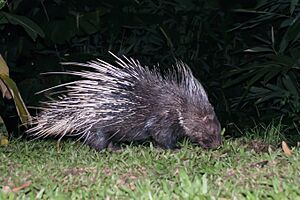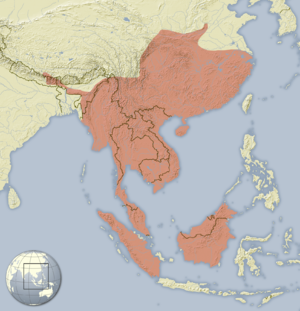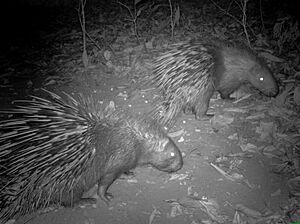Malayan porcupine facts for kids
Quick facts for kids Malayan porcupine |
|
|---|---|
 |
|
| Hystrix brachyura, Malayan porcupine - Kaeng Krachan National Park, Thailand | |
| Conservation status | |
| Scientific classification | |
| Genus: |
Hystrix
|
| Species: |
brachyura
|
| Subspecies | |
|
H. b. brachyura |
|
 |
|
The Malayan porcupine or Himalayan porcupine (Hystrix brachyura) is a type of rodent that belongs to the porcupine family. These animals are known for their sharp quills. You can find three different kinds, or subspecies, of this porcupine living today in South and Southeast Asia.
Contents
Where Malayan Porcupines Live
The Malayan porcupine lives in many countries across Asia. You can find them from Nepal and north-east India (in states like Arunachal Pradesh and Sikkim) all the way to Bangladesh and a large part of central and southern China. They also live throughout Myanmar, Thailand, Laos, Cambodia, and Vietnam. Further south, they are found in Peninsular Malaysia, Singapore, Sumatra (in Indonesia), and all over Borneo (which includes parts of Indonesia, Malaysia, and Brunei). They even live on Penang island in Malaysia. These porcupines can live from sea level up to high places, at least 1,300 meters (about 4,265 feet) above sea level.
How Malayan Porcupines Evolved
Scientists believe that Malayan porcupines and their close relatives first appeared in southern Asia. They likely share a common ancestor from a very long time ago, during the Late Pleistocene period. Back then, large landmasses like Sumatra, Borneo, and Palawan were connected as one big area called Sundaland.
Malayan Porcupine Habitat and Lifestyle
Malayan porcupines live on the ground and usually hang out in small groups. They prefer different kinds of forest areas, but you might also see them in open spaces near forests. Sometimes, they even wander into nearby farms.
These porcupines often make their homes in dens they find near rocky spots, or in holes within trees or big root systems. They can also dig their own burrows, which often have many paths leading out into the surrounding forest. They can live in all types of forests up to 1,500 meters (about 4,900 feet) high.
Malayan Porcupine Characteristics
The Malayan porcupine is a large, sturdy rodent. Its body is covered with sharp, stiff quills. These quills are actually special, modified hairs! The quills on their upper body are rough and have black stripes mixed with white or yellow. When young porcupines are born, their quills are soft, but they get hard as the porcupines grow up.
They have short, strong legs covered in brown fur. Their front legs have four claws, and their back legs have five. Both their front and back paws have smooth bottoms. A grown Malayan porcupine's head and body can be about 56 to 74 centimeters (22 to 29 inches) long, and their tail is about 6 to 11 centimeters (2.4 to 4.3 inches) long. They usually weigh around 10 to 18 kilograms (22 to 40 pounds).
What Malayan Porcupines Eat
Malayan porcupines mostly eat roots, tubers (like potatoes), tree bark, and fruits that have fallen to the ground. They also eat carrion (the meat of dead animals), insects, and large tropical seeds, such as those from the Chisocheton cumingianus plant.
Malayan Porcupine Behaviour and Reproduction
Hystrix brachyura is a nocturnal animal, which means it looks for food at night and rests during the day. You might see them alone or sometimes in pairs. These porcupines are also good swimmers and enjoy gnawing on things.
When it comes to reproduction, a female porcupine usually gives birth to one baby, called a pup, at a time. However, sometimes they can have two pups. The gestation period (how long the mother carries the baby) is about 90 to 112 days. They can live for a long time, sometimes up to 27 years!
Conservation Status and Importance
The International Union for Conservation of Nature (IUCN) has listed the Malayan porcupine as a species of Least Concern. This means that their population is currently stable and not at high risk of disappearing.
The quills of the Malayan porcupine are sometimes used for decorations. People also hunt porcupines for their meat and for use in traditional medicines in some areas.
Images for kids




